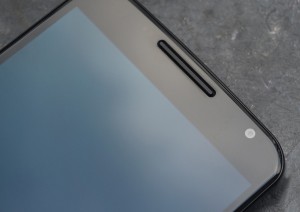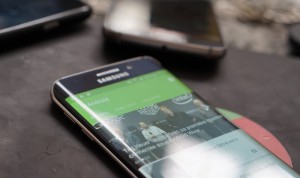We are dealing with a relatively new term related to the production technology of displays for mobile devices, getting acquainted with the features of production and assessing the prospects.

The 2.5D glass trend is perceived as stereotypical marketing slang, and how can something be in the space between 2D and 3D? Still, the term is based on real design, it's not just a name under which they try to sell you goofy display films.
When a 2.5D display is mentioned, it is a slight curvature of the glass surface at the edge of the device, also known as a contoured edge. The term is not official for any technology, although it is widely used to refer to this type of display design. On some devices, such a solution may not be noticed, but you can feel a single outline on gadgets in which the glass is not recessed into the case, but is located on top of it and is not protected by slightly raised frames.
Many devices have used glass with various kinds of rounded edges, but it has only recently become a more common marketing aspect as manufacturers have experimented with creating aesthetically distinct designs for their gadgets. You can easily guess the presence of such glass in a number of modern devices, for example, in Google Nexus 6, Xiaomi Mi Note and Apple iPhone 6.
Is it curved or not?
While not generally curved, the 2.5D display has Z-smoothed edges, which adds a slight curvature and is different from a 2D display. If you can't imagine, then a slide from the presentation Xiaomi Mi Note will serve as a good visual reinforcement.

The degree of bending depends on the idea of the designer. But even the smallest bend can be used to give the glass edge a smooth edge, while the more pronounced will look particularly stylish.
If you go further and actually bend the display, you get a pronounced 3D effect. Probably, such devices as LG G Flex 2 and Samsung Galaxy Note Edge / S6 Edge fall under this description, but the basis of their curved displays is a flexible substrate coupled with electronic components, which distinguishes them from 2.5D. Don't think these types of displays don't have curved edges, but it's important to understand the difference between the terms now that curved displays are becoming an increasingly prominent feature in phones.
Production
Despite all the buzz surrounding 2.5D glass, there is nothing special about its production. Considering the fact that the original components of the display are not in any way curved, as in a 3D display, such glass is produced in the same way as a panel with straight (not curved) glass, with the only difference being the final shape to the desired one at the stage of adjusting the glass to the required size.
Fortunately, this means that production methods of amplification can be used on 2.5D displays, such as installing Corning Gorilla Glass. Smartphone-sized glasses are cut from large glass and then another manufacturing process is used to trim and smooth the edge of the glass. This is a little more expensive, but it can give the impression of a “ premium design. '' After that, the glass of the desired shape can undergo a tempering process by heating to a very high temperature in a molten salt solution, followed by rapid cooling to shrink the glass. It is this order (fitting and tempering) that provides structural integrity and strength that can be compromised when attempting to reshape glass near the end of the production cycle.
By comparison, to produce fully curved displays such as the G Flex 2 or Galaxy S6 Edge, the crystal display board and light elements such as diodes OLED and LCD must be tightly adhered to the bend. The production of such flexible boards is more complex and expensive than the production of curved glass itself.
Benefits
The use of 2.5D glasses gives an advantage in the ergonomics and aesthetic perception of the device. For touch devices, it is especially important to ensure that any surface that a potential user will interact with is perfectly smooth. There is hardly anyone who wants to cut their finger on the sharp edge of the glass. 2.5D displays are also installed in devices with frames, just to protect fingers from the sharp edge. Just remember the story of the Note 4 deliberately incorporating a small gap between the metal frame and the case, it would be extremely wrong to open the sharp edge in this gap.

Returning to smartphones with a curved display, 2.5D looks a little better compared to the raised bezels above the display and helps to ensure that the glass covers the body more beautifully. The durability and strength of such displays is determined by the peculiarities of the production technology, rather than something inherent in the 2.5D class. characteristics.
The only disadvantage of such glasses can be felt by users who prefer to use additional protection for the display (film, glass, etc.). Manufacturing protection for curved displays requires a separate, relatively complex and more expensive manufacturing process.
In general, the term '2.5D' has its own meaning, but at the same time it is not any breakthrough in terms of technology that can give one device superiority over another. Yes, using technology allows for beautifully designed devices, but that should by no means be a key reason to buy.
Original article by Rob Triggs
Elir: Alexander Noskov described marketing tricks well in his article, but in the case of 2.5D, there are still certain practical and aesthetic components that distinguish the term from other loud slogans sucked from the finger to attract attention. For some reason, the author of the article did not indicate that despite all the strength and reliability of such glasses, a lot depends on the design of the case, because the same iPhone 6 with 2.5D glass beats an order of magnitude easier and more often than its straight competitor to Note 4.
